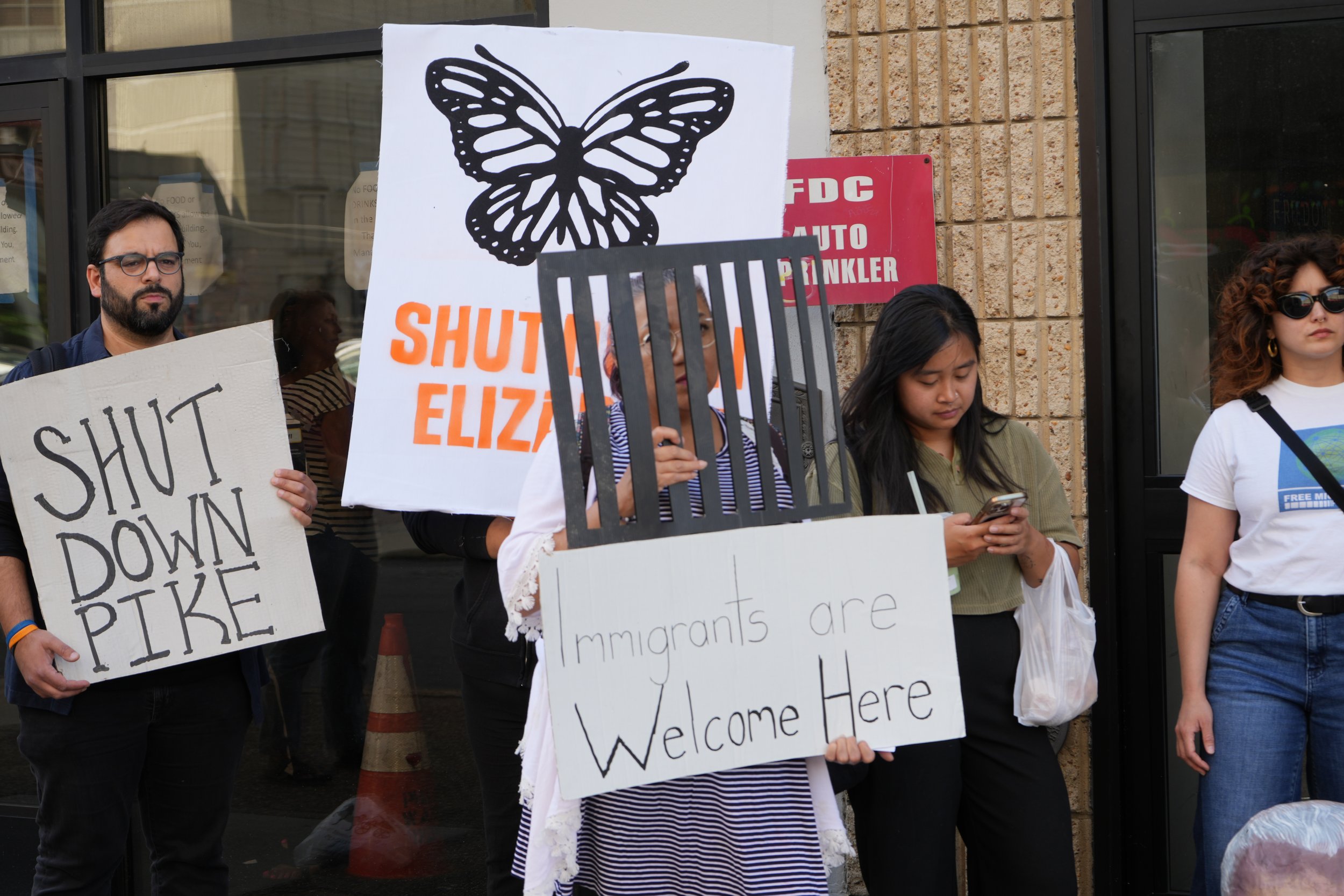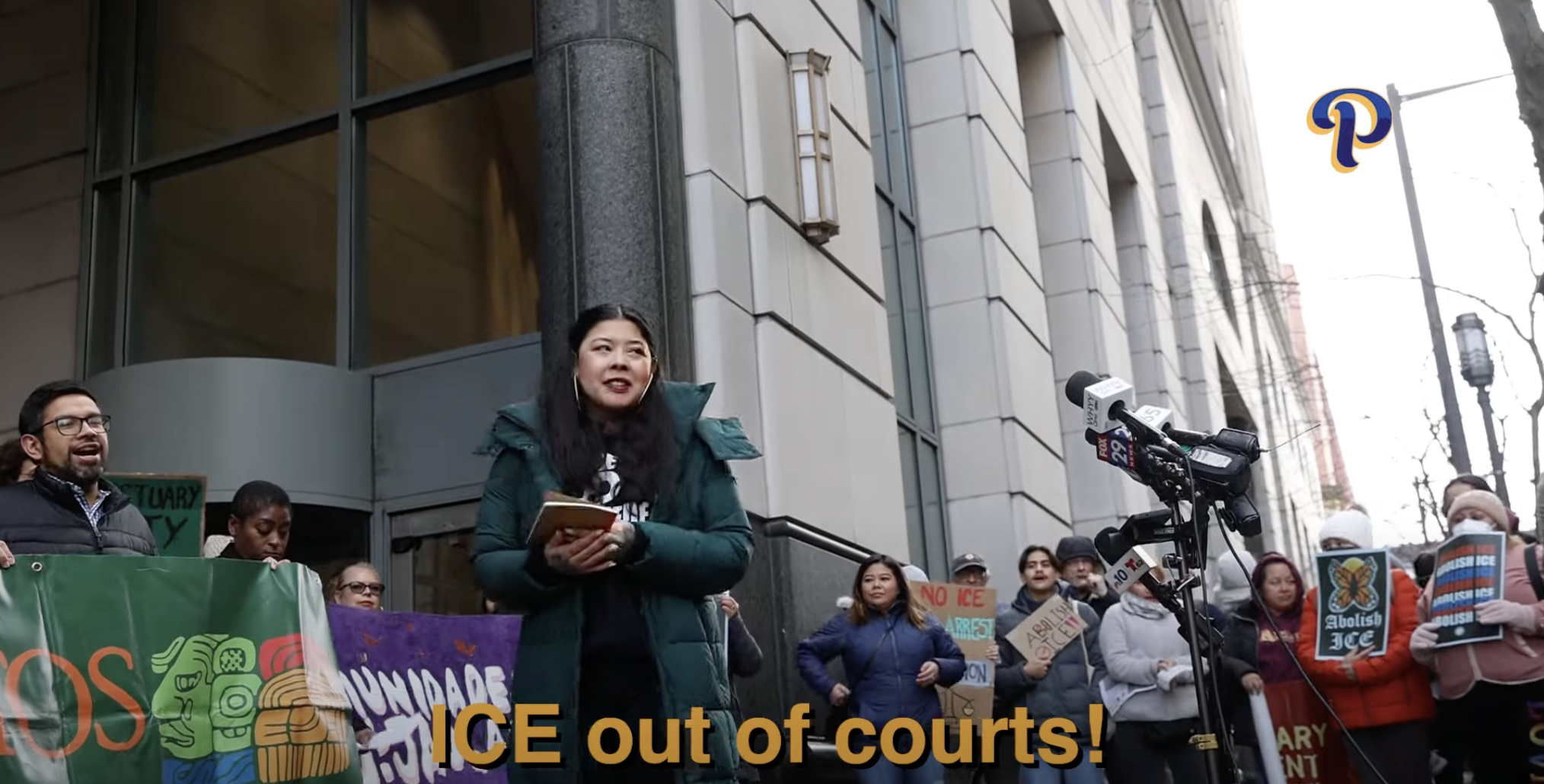Being a Woman In Mexico During The Pandemic: When Staying Home Doesn’t Mean Staying Safe
BY ANA LAURA PEREZ FLORES ON OCTOBER 6, 2020
The Human Rights National Commission (CNDH) that was turned into a shelter by protesters. There are pictures of femicide victims and signs claiming for justice hanging and a table with the donations received. September 14, 2020, Mexico City, Mexico. (Ana Laura Pérez Flores for ¡Presente! Media)
The COVID-19 virus has taught us to be extremely cautious and to anticipate any potential menace to our physical integrity. We have learned to keep our distance, to wear appropriate gear and to stay alert in case of any possible danger. It has turned the simple act of leaving home into an exhaustive ritual of safety and hygiene. Every single step we take, every single place we visit, every single person with whom we interact, has turned into a potential threat to our lives. Well, this is nothing new for Mexican women: for many decades now, our daily lives have been a permanent struggle for survival.
There’s no way to euphemize this: there’s an ongoing war on women and it doesn’t seem to get any better. We live in a country where ten femicides[1] take place every day, and according to official sources, 40% of these crimes are committed at home.
During March 2020, the month in which Mexico officially began its quarantine, emergency calls related to gender violence–including rape, sexual harassment, and domestic violence–increased 22%, according to Iniciativa Spotlight, a global campaign organized by the European Union and the United Nations.
8 year-old girl from the shelter. Her hood reads FREE / ALIVE. Throughout the concentration on September 14th, she looked happy and safe, she knew every feminist chant and it was hard to tell who was her mother, since all the women took care of her and showed her affection. Mexico City, Mexico. (Ana Laura Pérez Flores for ¡Presente! Media)
The government’s main advice against the global threat of COVID-19 is to stay home–#QuédateEnCasa is the slogan chosen by authorities. With the machista violence–within the home or on the streets–or the deadly virus, the truth is, there’s no safe place for women in Mexico.
Authorities, however, fail to acknowledge this crisis. Instead, the government insists on creating weak actions, such as the “Cuenta hasta 10” campaign, that among other messages, suggests that people count to ten in order to avoid unfortunate episodes of violence, thus refusing to look at the problem in all its complexity. Meanwhile, President Andrés Manuel López Obrador keeps stating troubling messages that perpetuate the ideas that enable these manifestations of violence. Messages such as assuring that “…the tradition in Mexico says that the daughters are the ones who take care of the parents; men are more detached, but daughters are always looking after their parents” further the Machista assumption that daughters and spouses are naturally bound to take care of domestic duties, even when the whole family is staying at home 24/7. At the same time, the Federal Government has decided to drastically reduce the budget for shelters and institutions dedicated to women’s welfare as a part of a general austerity policy.
Plaque in front of the Human Rights National Commission (CNDH) turned into a shelter by feminist groups. It features the most famous quote of Benito Juárez, national hero and former president of Mexico (1861–72): “Among individuals as among nations, respect to the others’ right equals peace.” The graffiti reads “Which respect?” September 14, 2020, Mexico City, Mexico. (Ana Laura Pérez Flores for ¡Presente! Media)
This bleak panorama is nothing new, but like many other social urgencies, it has undoubtedly become harsher due to the pandemic. Having to face an absent state and a neglectful society, Mexican women have found ways to weave their own strong and disruptive social fabric to build their own safe spaces. Even though there’s still a significant part of the population that remains skeptical, the feminist groups and initiatives seem to grow stronger and closer by facing adversity. This was especially clear when around 80,000 women of different ages and social strata gathered in Mexico City for the Women’s Day march on March the 8, 2020, in order to protest against this violence that reaches all of us in one way or another. Then COVID-19 arrived and women were somehow paralyzed, many of them confined to closed spaces with their own abusers.
This came to a halt during September 2020, when the outrage became stronger than the fear of the virus and many women returned to the streets to support Marcela Alemán, a mother that tied herself to a chair at the Human Rights National Commission (CNDH) in Mexico City in order to demand justice for her underage daughter who was raped. Several families and feminist groups decided to acuerpar–which means stand up for one another, literally, to put the body–and call for justice. Feminist groups became some sort of front-line for the occupation of the building, which has since sheltered several families, children and women who have been constantly neglected by the authorities and are in desperate need of safety. Many CNDH headquarters all around the country have been symbolically taken or intervened by feminists as a sign of support; thousands of people have also donated goods for them and the victims’ families.
One day before the traditional “Grito de Independencia,” which is celebrated each year on September 15th as the Mexican Independence Anniversary, hundreds of women gathered in front of this office-turned-shelter to celebrate their own counter-holiday. Mothers of victims from throughout the country occupied a balcony, just as the President does during the festivities, and screamed their names and stories. Feminist artists performed songs of rage, sorority, and healing. A piñata shaped like the President was set on fire as a response to his constant undermining of the situation. Elder women, young mothers, little girls and masked feminist groups and protesters danced, held hands and united their voices in a scream for justice.
Feminist collective, self-named “Bloque Negro” (or “Black Block”), holding a Mexican flag from one of the building’s balconies during the concentration on September 14th, in Mexico City. The flag reads: México Feminicida (Femicide Mexico). (Ana Laura Pérez Flores for ¡Presente! Media)
It’s not without meaning that among all the institutions these groups could have taken, the one focused on human rights was chosen for this sort of reactivation of feminist public acts. Even though it’s not properly a government dependent agency, it’s supposed to be an ally for victims of all crimes. The decision of turning it into a shelter for victims, even if it didn’t prevail, has a tremendous meaning. It’s not only the state that’s failing women; it’s the society and public opinion as a whole: women’s rights are simply not a priority at any level in Mexico.
There’s no way to know how this particular protest will evolve or how each of the cases that fill the charts will be resolved. However, there’s a feeling of resistance, of history being made not only beyond the pandemic but also despite the pandemic. There’s a void that these acts pretend to eradicate. Mexican women have historically lived with social deprivation, but will no longer stay silent before it. Mothers who have had their daughters murdered by their romantic partners, rape survivors of all ages, women who have chosen the streets before returning home with their abusers, all are voices that have been systematically silenced by the state and forced to search for shelter and support elsewhere.
Little girl resting during the feminist concentration on September 14th in Mexico City, Mexico. Her sign read: “Girls must not be touched, raped or murdered.” (Ana Laura Pérez Flores for ¡Presente! Media)
This pandemic has certainly been an unexpected crisis for humankind, but as we’ve learned through previous crises of all sorts, these events do not affect us all to the same extent. It would certainly be naïve to think so. Being safe when one is home should not be a privilege, yet in Mexico and many other homes in Latin America it is. Even though this particular series of protests was triggered by one woman’s case, the decision of hundreds of women around the country to leave their homes for the first time during this pandemic and raise their voices is proof that in times when staying home is supposed to mean staying safe, Mexican women know this to be a lie. The real threat is bigger and older than the virus, and just as it will outlive the virus, these bonds of resistance will remain as a way to not only survive, but work towards a better life for today’s women and the women to come.
[1] According to the Federal Penal Code, a murder is considered a femicide if: 1) the victim presents signs of sexual violence of any kind; 2) the victim suffered degrading or humiliating mutilations before or after the loss of life; 3) there’s any domestic violence history or violence in work or study spaces involving the perpetrator; 4) there was a romantic, affective or confidence relationship between them; 5) there’s any trace of threats against the victim; 6) the victim’s communication was cut before the loss of life; or 7) the corpse was exposed in a public place.















